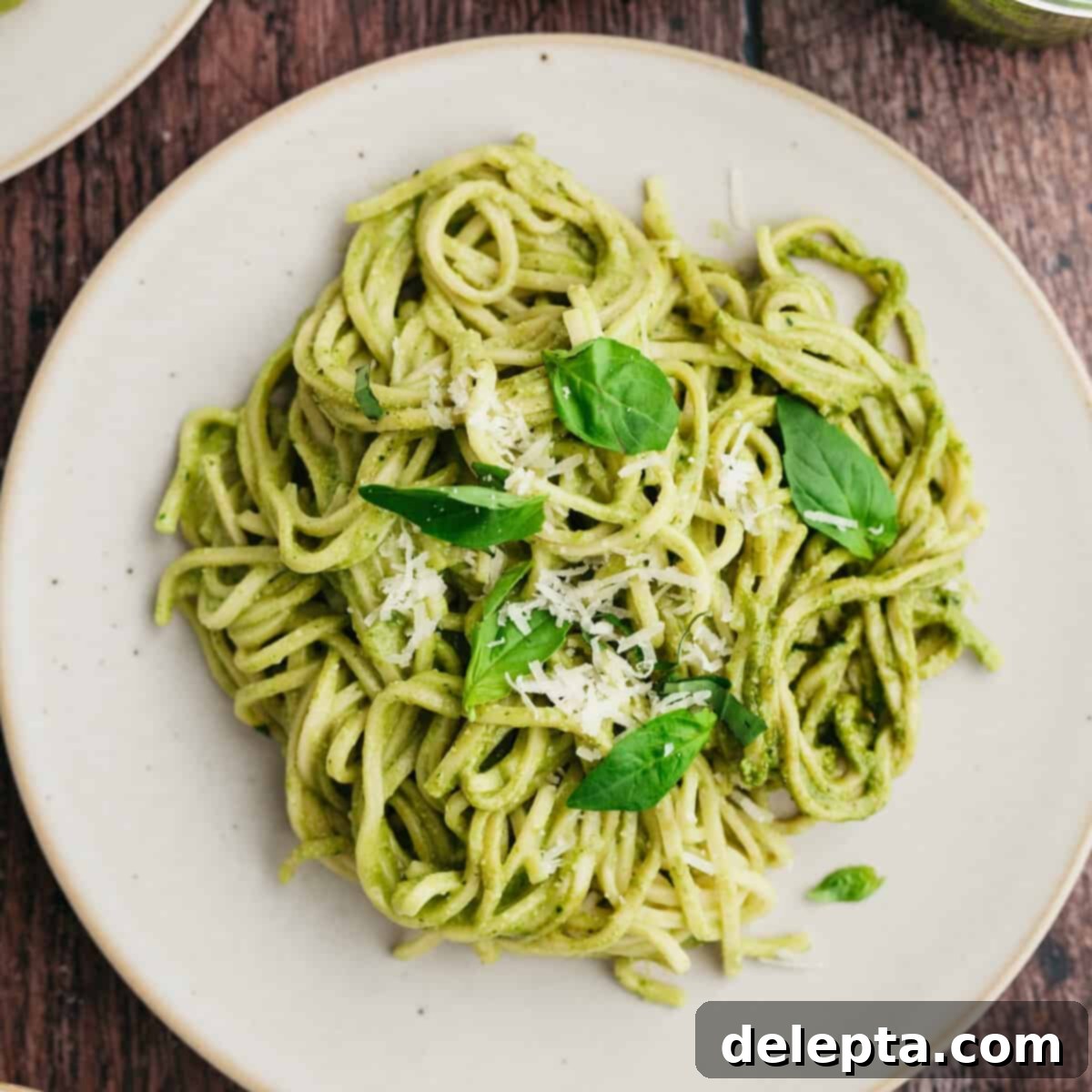The Ultimate 20-Minute Pasta al Pesto: Fresh, Creamy & Irresistibly Easy
Prepare to elevate your weeknight dinner game with this incredibly flavorful and satisfying pasta al pesto recipe. Crafted with vibrant homemade pesto, this dish comes together in just 20 minutes, delivering a creamy, aromatic, and utterly delicious experience that will transport your taste buds straight to the heart of Italy. Whether you’re a seasoned chef or a busy home cook looking for a quick yet gourmet meal, this pesto pasta is your new culinary secret weapon.
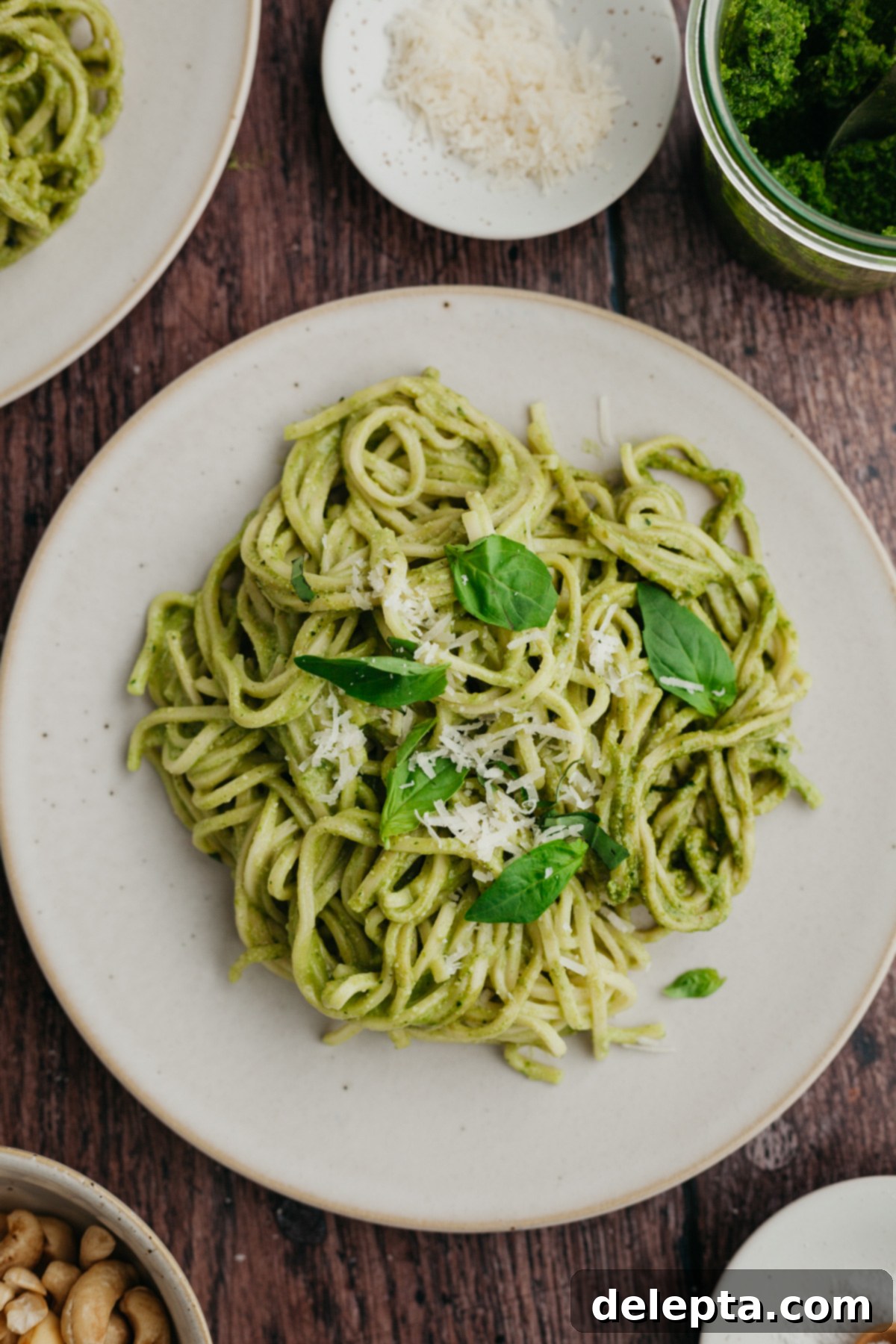
This simple yet profoundly satisfying pasta al pesto recipe is designed for maximum flavor with minimal effort. While the star of the show is undeniably the homemade pesto, made here with a delightful cashew base (no pine nuts required!), you can certainly opt for a high-quality store-bought pesto if time is of the essence. We’ve paired it with classic spaghetti, transforming it into a delightful “spaghetti al pesto,” but feel free to experiment with any pasta shape you adore – from fettuccine to penne, the choice is yours!
More than just a quick weeknight solution, this creamy pesto pasta is versatile enough to grace your most special dinner parties. Serve it alongside some crusty garlic bread and a crisp green salad for a complete and elegant meal that guests will rave about. Its vibrant green hue and fresh aroma make it a beautiful addition to any table.
For those craving more delicious pasta adventures, be sure to explore my other popular recipes like the fiery spicy vodka pasta, the comforting rigatoni al forno, the delicate salmon pasta with creme fraiche, and the indulgent gnocchi carbonara. Each offers a unique and satisfying culinary journey.
[feast_advanced_jump_to]
Why You’ll Fall in Love with This Pesto Pasta Recipe!
- Effortlessly Simple Ingredients: This recipe champions simplicity, utilizing readily available ingredients to create extraordinary flavors. No fancy, hard-to-find items here – just pure, fresh goodness that makes a difference.
- Superior Homemade Pesto: The secret to truly exceptional pesto pasta lies in the sauce itself. Our homemade pesto elevates the dish beyond anything store-bought can offer. We feature a delicious cashew pesto, but the recipe is adaptable for traditional pine nuts or other nuts if you prefer, allowing you to customize your fresh basil pesto perfectly.
- The Ultimate Weeknight Dinner: In just 20 minutes, you can transform simple ingredients into a gourmet meal. This makes it an ideal choice for busy evenings when you crave something wholesome, satisfying, and quick to prepare without sacrificing taste.
- Excellent for Meal Prep: The homemade pesto can be prepared several days in advance, significantly cutting down on cooking time during the week. This flexibility makes weeknight dinner planning a breeze and ensures you always have delicious, fresh pesto on hand.
- Versatile and Customizable: Whether you prefer a different type of pasta, want to add protein like grilled chicken or shrimp, or wish to incorporate extra vegetables, this pesto pasta recipe is incredibly adaptable to your preferences and dietary needs.
- Authentic Italian Flavors: Experience the true essence of Italian cuisine with fresh basil, high-quality olive oil, and rich Parmesan cheese. This recipe brings the authentic taste of Liguria right to your kitchen.
The Rich History and Origin of Pesto
Before diving into the delicious details of this specific pasta al pesto recipe, let’s appreciate the heritage of this beloved sauce. Pesto, or Pesto alla Genovese, originates from Genoa, the capital city of Liguria, Italy. The word “pesto” itself comes from the Italian word “pestare,” which means to crush or to pound, referring to the traditional method of making the sauce with a mortar and pestle. This time-honored technique involves crushing fresh basil leaves with garlic, pine nuts, hard cheese (Parmesan and Pecorino Sardo), and olive oil until a vibrant, aromatic paste is formed.
While pine nuts are traditionally associated with pesto, variations have existed for centuries, adapting to local ingredients and preferences. Our cashew pesto offers a creamy, slightly sweeter twist while maintaining the classic basil-forward flavor profile. This rich history reminds us that at its core, pesto is about celebrating fresh, quality ingredients and simple, robust flavors.
Essential Ingredients for Perfect Pesto Pasta
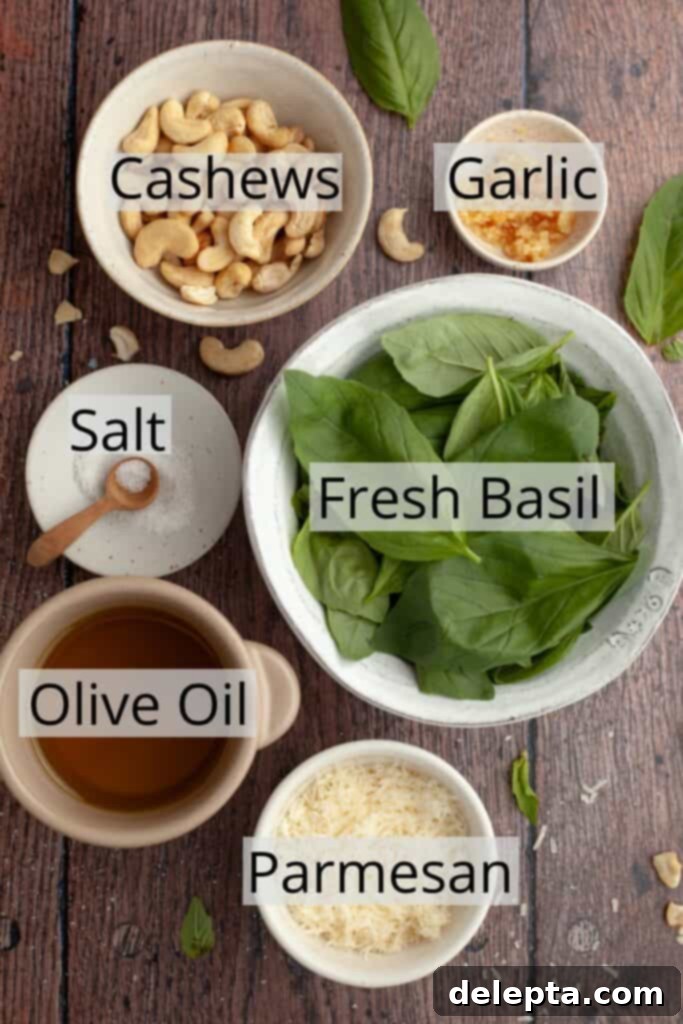
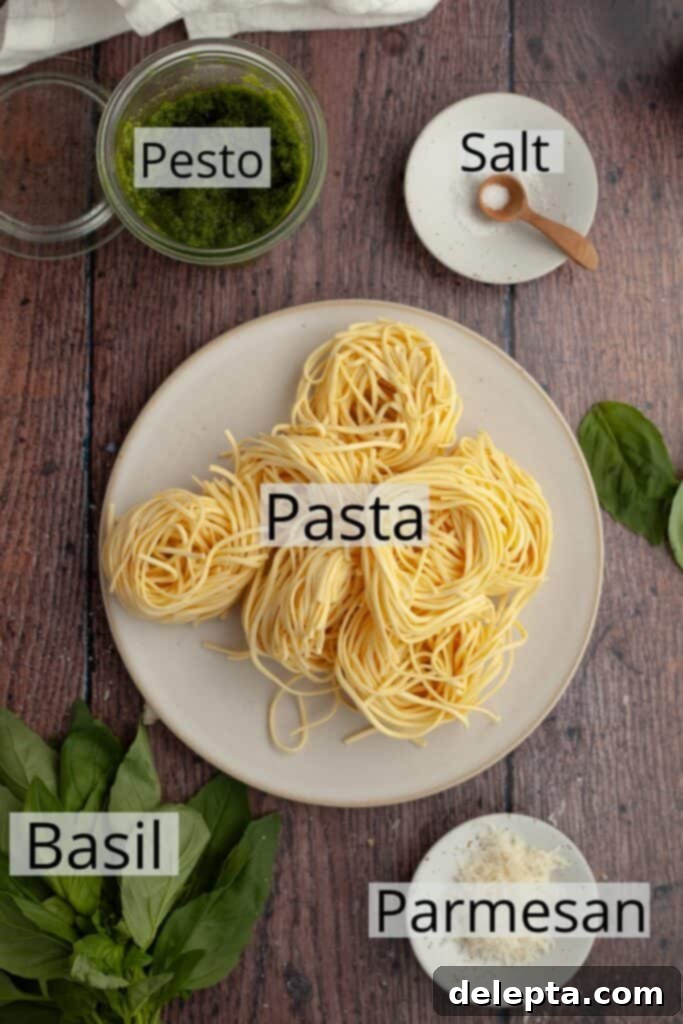
Creating an exceptional pesto pasta begins with selecting the finest ingredients. Here’s a closer look at what you’ll need to bring this dish to life:
- Cashews (or Pine Nuts): For this specific recipe, we’re using raw cashews, which impart a wonderfully creamy texture and a subtle, sweet flavor to the pesto. If you prefer the classic taste, pine nuts are an excellent substitute. You can also experiment with walnuts or pistachios for different flavor profiles. Lightly toasting your chosen nuts beforehand can deepen their flavor significantly.
- Fresh Basil Leaves: This is the soul of pesto! Always opt for fresh basil with vibrant green leaves that are plump and free from wilting or dark spots. The fresher the basil, the more aromatic and flavorful your pesto will be. Avoid dried basil at all costs for this recipe.
- Extra Virgin Olive Oil (EVOO): The quality of your olive oil directly impacts the final taste of your pesto. Invest in a high-quality, fruity extra virgin olive oil. It not only binds the ingredients together but also contributes a rich, peppery depth to the sauce.
- Garlic: We recommend 2 cloves for a robustly garlicky pesto, but you can adjust this to your personal preference. For a milder flavor, use 1 clove or even roast the garlic beforehand to soften its intensity. Freshly minced garlic is always superior to pre-minced jarred versions.
- Parmesan Cheese: For the best texture and flavor, grating your own block of Parmigiano Reggiano is highly recommended. Pre-grated cheeses often contain anti-caking agents that can affect the smoothness of your pesto. Alternatively, Pecorino Romano cheese offers a sharper, saltier kick, which some prefer.
- Fresh Spaghetti: While fresh spaghetti cooks quickly and offers a delightful chew, high-quality dried spaghetti works perfectly well. The key is to choose a pasta made from good durum wheat. Don’t limit yourself to spaghetti; other long pasta shapes like fettuccine, linguine, or even shorter shapes like penne or fusilli can be used.
- Salt: Essential for seasoning both the pasta water and balancing the flavors in the pesto. Use sea salt or kosher salt for the best results.
Exciting Substitutions & Creative Variations
One of the beauties of pesto pasta is its adaptability. Feel free to get creative and tailor this recipe to your taste, what you have on hand, or specific dietary needs.
- Nut Alternatives: Instead of cashews or traditional pine nuts, try walnuts for an earthier flavor, or pistachios for a slightly sweeter, richer pesto. Almonds can also be a good option. Lightly toasting any nuts before blending will enhance their aroma.
- Pasta Shape Swap: While spaghetti is classic, this creamy pesto sauce pairs beautifully with other pasta varieties. Consider using broad flat noodles like fettuccine or tagliatelle, thin linguine, or even shorter shapes such as penne, fusilli, or orecchiette, which perfectly cup the sauce.
- Boost Your Protein: Transform this side dish into a complete meal by adding your favorite protein. Grilled chicken breast, pan-seared shrimp, flaky baked salmon, or even crispy pancetta or bacon are fantastic additions that complement the rich pesto flavor.
- Add Fresh Vegetables: For a burst of freshness and color, garnish your pesto pasta with sliced cherry tomatoes, sun-dried tomatoes, blanched green beans, or roasted asparagus tips. A handful of fresh spinach or arugula stirred in at the end can also add nutritional value and a peppery bite.
- Cheese Options: If you’re out of Parmesan or prefer a different profile, swap it for Pecorino Romano for a sharper, saltier taste. For a dairy-free or vegan option, use a high-quality vegan parmesan alternative or nutritional yeast for a cheesy umami flavor.
- Time-Saving Shortcut: While homemade pesto is superior, a good quality store-bought pesto is a perfectly acceptable alternative when you’re truly pressed for time. Just ensure it’s a brand you trust for flavor.
- Herb Combinations: While basil is king, don’t hesitate to add a small amount of other fresh herbs like parsley or mint for a slightly different dimension.
- Add a Citrus Zing: A squeeze of fresh lemon juice stirred into the finished pesto can brighten the flavors and add a lovely acidic counterpoint, especially if you find your pesto a bit too rich.
Step-by-Step Guide to Your Perfect Pesto Pasta
Follow these simple steps to create a delightful and authentic pasta al pesto that will impress every time.
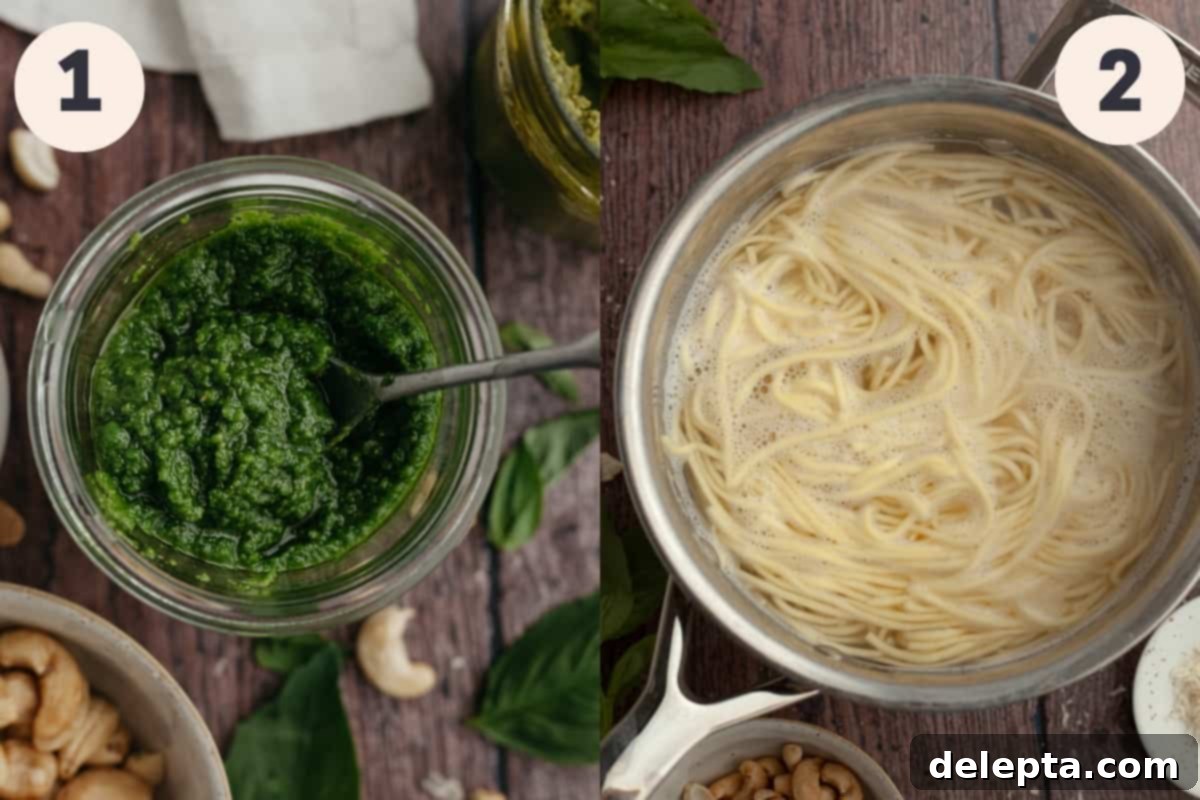
Step 1: Prepare Your Fresh Pesto. Begin by gathering all your pesto ingredients: cashews (or pine nuts), fresh basil leaves, garlic cloves, grated Parmesan, a pinch of salt, and high-quality extra virgin olive oil. Combine them in a food processor or a high-speed blender. Pulse until you reach your desired consistency – whether you prefer a slightly chunky texture with a bit of bite or a smooth, creamy sauce. Once blended, transfer the homemade pesto to an airtight jar. To keep it vibrant green and prevent oxidation, pour a thin layer of olive oil over the top before sealing. Store it in the fridge until you’re ready to use it, ideally no longer than a week for optimal freshness.
Step 2: Cook the Pasta to Perfection. Fill a large pot with water and generously salt it – this is your only chance to season the pasta itself! Bring the salted water to a rolling boil. Add your chosen pasta (spaghetti, in our case) and cook according to the package directions, aiming for an al dente texture. This means it should be firm to the bite, not mushy. Cooking al dente prevents it from becoming overly soft when tossed with the warm pesto.
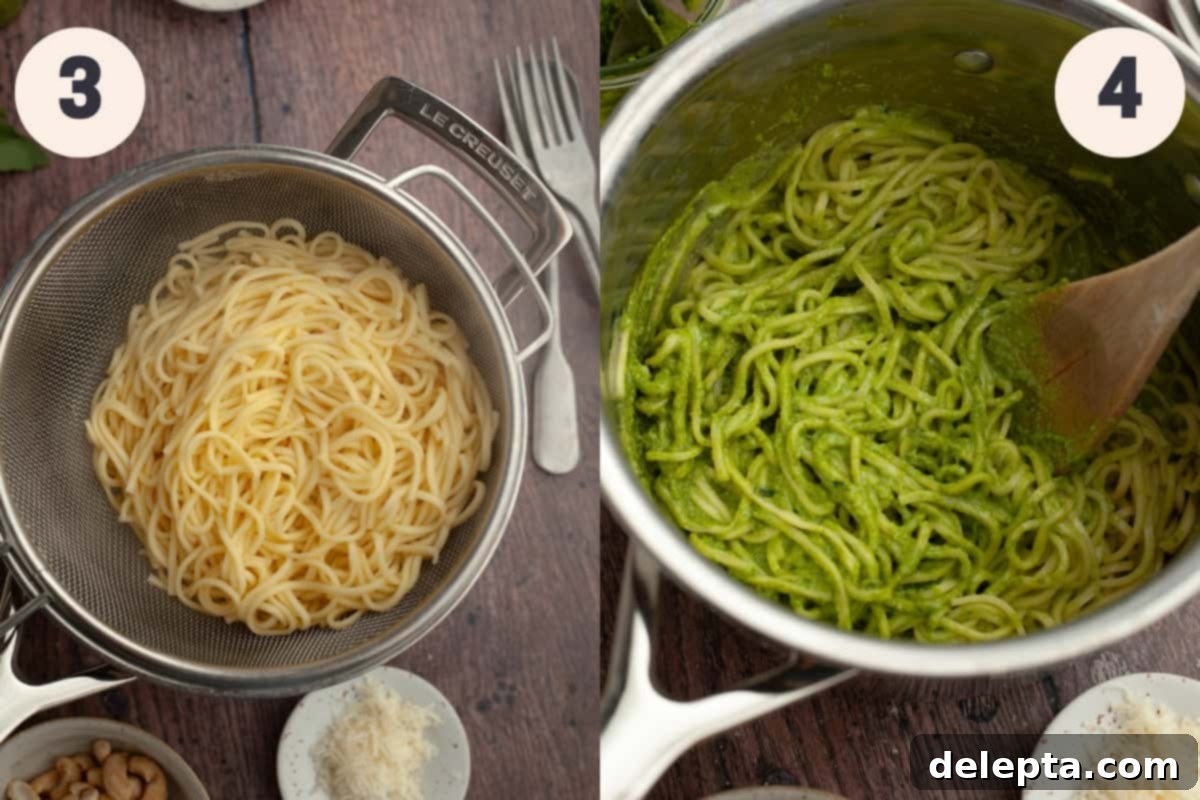
Step 3: Reserve Pasta Water & Drain. Before draining the pasta, use a heatproof measuring cup to scoop out approximately 1 cup of the starchy pasta water. This “liquid gold” is essential for adjusting the consistency of your pesto sauce later. Once the water is reserved, proceed to drain the cooked pasta thoroughly in a colander.
Step 4: Combine Pasta and Pesto. Return the drained pasta to the empty pot (off the heat) or a large serving bowl. Add a generous amount of your freshly made or store-bought pesto. Using a large spoon or tongs, gently toss everything together until the pasta is evenly coated with the vibrant green sauce. If the pesto appears too thick or sticky, gradually drizzle in some of the reserved pasta water, a tablespoon at a time, until the sauce achieves a smooth, glossy consistency that clings beautifully to the pasta.
Step 5: Garnish and Serve Immediately. Plate your delicious pesto pasta and finish with a flourish! Generously garnish each serving with extra freshly grated Parmesan cheese and a scattering of fresh basil leaves. For an extra pop of color and flavor, consider adding a sprinkle of freshly cracked black pepper or a drizzle of your best extra virgin olive oil. Serve immediately and enjoy the fresh, aromatic flavors!
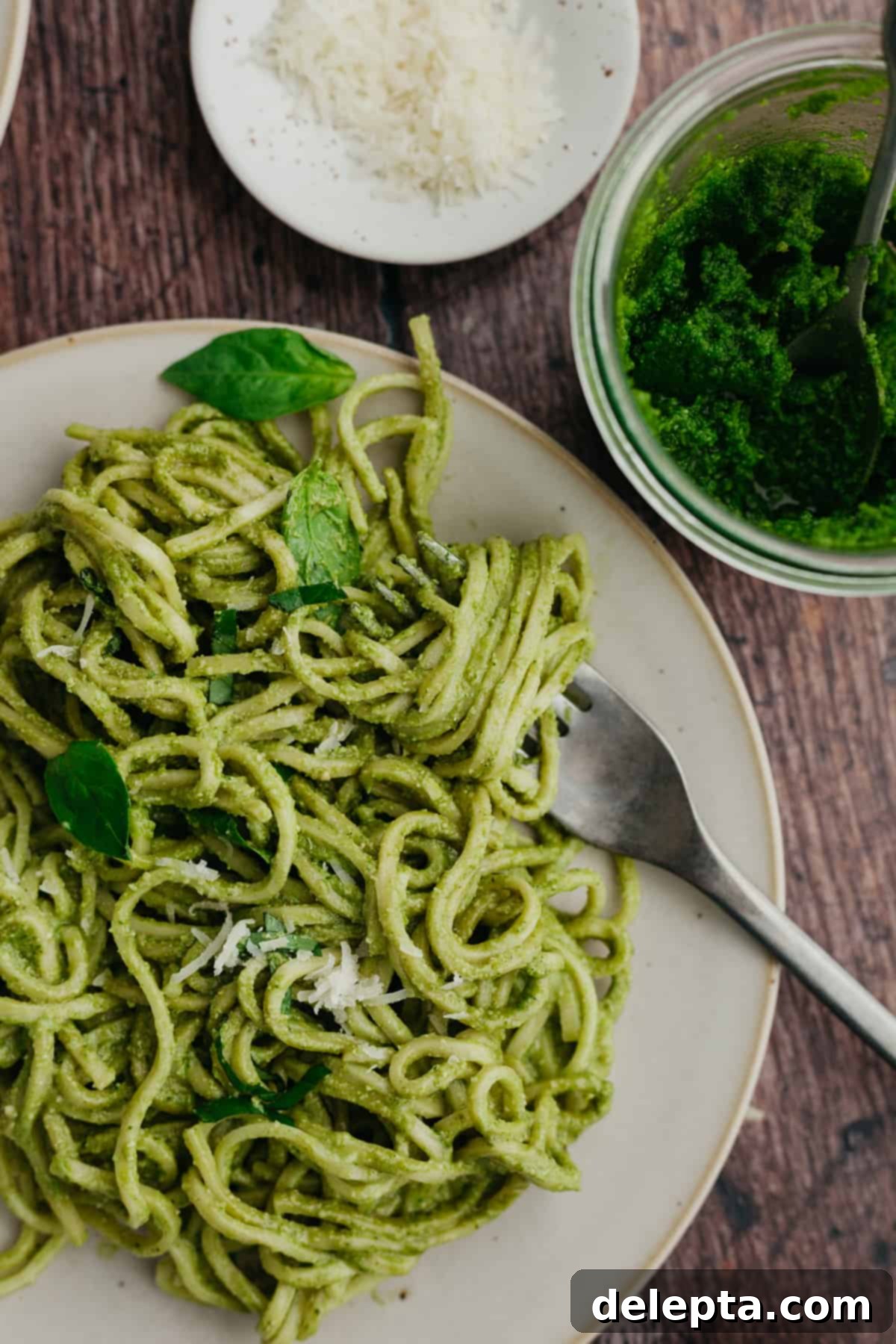
Expert Tips & Tricks for the Best Pesto Pasta
Mastering pasta al pesto is all about understanding a few key techniques and embracing high-quality ingredients. These expert tips will help you achieve restaurant-quality results every time:
- Achieving Perfect Al Dente Pasta: The phrase “al dente” means “to the tooth” in Italian, referring to pasta that is cooked through but still firm when bitten. To achieve this, cook your pasta about one to two minutes less than the package directions suggest. This ensures your spaghetti maintains a pleasing chew and doesn’t become mushy or floppy when mixed with the sauce. Test a strand a minute or two before the suggested cooking time.
- The Magic of Pasta Water: Never underestimate the power of reserved pasta water! This starchy, salty liquid is your secret ingredient for achieving a silky, emulsified pesto sauce that beautifully coats every strand of pasta. The starch helps to bind the pesto to the pasta, while the salt enhances the overall flavor. Gradually add it to your pasta and pesto mixture, a tablespoon at a time, until you reach your desired consistency.
- Prepare Pesto Ahead of Time: Homemade pesto is incredibly convenient for meal prep. You can easily make a batch up to a week in advance. Store it in an airtight jar in the refrigerator. To preserve its vibrant green color and freshness, pour a thin layer of extra virgin olive oil over the surface of the pesto before sealing the jar. This creates a barrier that prevents oxidation.
- Invest in High-Quality Ingredients: The simplicity of pesto means that the quality of each ingredient shines through. Use the best extra virgin olive oil you can afford, freshly grated Parmigiano Reggiano (or Pecorino Romano), and, most importantly, super fresh, aromatic basil. These superior ingredients will make a noticeable difference in the depth and complexity of your final dish.
- Fresh vs. Dried Pasta: While this recipe calls for fresh spaghetti, which cooks quickly and has a delicate texture, high-quality dried pasta is also an excellent choice. Just be mindful that cooking times will differ significantly. Dried pasta typically takes longer and often has a firmer bite, which some prefer. Always follow package instructions and aim for al dente.
- A Touch of Acidity with Lemon Juice: If you find your homemade basil pesto a bit too rich or if you desire a brighter, more zesty flavor, a small squeeze (1-2 teaspoons) of fresh lemon juice can work wonders. Add it at the end, taste, and adjust as needed.
- Toasting Nuts for Depth: For an even richer, nuttier flavor in your pesto, lightly toast the cashews (or pine nuts, walnuts, pistachios) in a dry skillet over medium-low heat for a few minutes until fragrant and lightly golden. Be careful not to burn them! Let them cool completely before blending.
- The Basil Blanching Trick (Optional): For an intensely green pesto that retains its color, some chefs briefly blanch the basil leaves in boiling water for about 10-15 seconds, then immediately plunge them into an ice bath before drying thoroughly and blending. This stops enzymatic action that causes browning. However, it can slightly reduce the fresh basil flavor, so it’s a trade-off.
Serving Your Delicious Pesto Pasta
This versatile pasta al pesto can be the star of your meal or a delightful accompaniment. Here are some ideas to complete your dining experience:
- Classic Companions: Serve with a simple green salad dressed with a light vinaigrette and a side of warm, crusty garlic bread. This classic pairing is always a crowd-pleaser.
- Add Protein: Enhance the meal by serving alongside grilled chicken, pan-seared shrimp, baked salmon, or even crispy prosciutto or bacon bits.
- Vegetable Boost: Toss in some roasted cherry tomatoes, blanched green beans, or steamed asparagus during the last minute of cooking for extra color and nutrients.
- Wine Pairing: A light, crisp white wine like a Sauvignon Blanc, Pinot Grigio, or a Vermentino would beautifully complement the fresh, herbaceous flavors of the pesto.
Recipe FAQs: Your Pesto Pasta Questions Answered
No, there’s generally no need to heat up the pesto beforehand. Once you’ve drained the hot pasta, return it to the pan (off the heat) or a large serving bowl. The residual heat from the freshly cooked pasta, along with any reserved warm pasta water you add, will gently warm the pesto, allowing its flavors and aromas to bloom beautifully without “cooking” the fresh basil, which could dull its color and flavor.
Saving a cup of starchy pasta water is a crucial step for achieving the perfect pesto sauce consistency. This salty, starchy liquid acts as a natural emulsifier, helping the pesto to coat the pasta smoothly and evenly. If your pesto seems too thick or isn’t clinging well to the pasta, gradually stir in a tablespoon or two of this reserved water until you reach your desired creamy consistency. It truly transforms the texture of the sauce.
Absolutely! To make this pesto pasta vegetarian, you only need to ensure your Parmesan cheese is suitable. Traditional Parmigiano Reggiano contains animal rennet, making it non-vegetarian. However, many brands offer vegetarian Parmesan or hard Italian-style cheeses made with microbial rennet. For a fully vegan option, simply swap out the Parmesan for a high-quality vegan Parmesan alternative or nutritional yeast, which provides a lovely cheesy, umami flavor.
Yes, our cashew pesto offers a very similar, delightful flavor profile to traditional pine nut pesto, often described as even creamier and slightly sweeter. The key to ensuring it tastes authentic lies in using genuinely fresh basil leaves, a high-quality extra virgin olive oil, and good Parmesan. The cashews provide a fantastic texture and nutty base that perfectly complements the other classic pesto ingredients.
Yes, homemade pesto freezes wonderfully! To freeze, transfer the pesto into ice cube trays, covering the top of each cube with a thin layer of olive oil to prevent discoloration. Once frozen solid, pop the pesto cubes out and transfer them to an airtight freezer bag or container. This method allows you to portion out just what you need for future meals. Frozen pesto can last for several months, making it perfect for enjoying fresh flavors year-round.
To keep fresh basil vibrant and extend its shelf life, treat it like a bouquet of flowers. Trim the stems, place them in a glass of water, and cover loosely with a plastic bag. Store it on your countertop at room temperature, away from direct sunlight. Avoid refrigerating fresh basil directly, as it can blacken quickly. Changing the water every day or two will help it stay fresh for up to a week.
Expand Your Culinary Horizons with More Delicious Pasta Recipes!
If you’ve enjoyed the fresh, vibrant flavors of this Pesto Pasta, you’ll love exploring more of our delightful pasta dishes designed to satisfy every craving. From comforting baked pasta to spicy weeknight wonders, there’s always something new to try.
- Spicy Vodka Pasta
- Rigatoni al Forno
- Salmon Pasta with Crème Fraîche
- Gnocchi Carbonara
If you’ve made this incredibly delicious recipe, we would be absolutely thrilled to hear about your experience! Make sure to leave a ⭐️ rating and review below – your feedback helps us and other home cooks. We love seeing when you create our recipes, so please tag me on Instagram @alpineella so I can share your culinary masterpieces! You can also follow along on Pinterest, Facebook, and TikTok for more daily inspiration and recipes. Happy cooking!
Recipe Card: Quick & Easy Pasta al Pesto
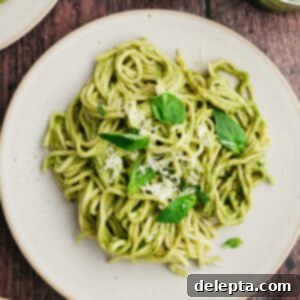
Pasta al Pesto: Fresh Basil & Cashew Delight
Ella Gilbert
Pin Recipe
Save RecipeSaved!
Ingredients
For the Cashew Basil Pesto
- ½ cup raw cashews (or pine nuts for classic pesto)
- 2 garlic cloves peeled
- 3 ½ cups fresh basil leaves, packed
- ½ cup Parmesan freshly grated
- salt or to taste
- ½ cup extra virgin olive oil plus more for topping
- 1-2 teaspoons fresh lemon juice (optional, for acidity)
For the Pasta
- 12 oz fresh spaghetti (or dried, your preferred shape)
- Salt for pasta water
- grated Parmesan to garnish
- fresh basil to garnish
Instructions
-
Prepare the Cashew Basil Pesto: In a food processor or high-speed blender, combine the raw cashews (or pine nuts if using), peeled garlic cloves, fresh basil leaves, freshly grated Parmesan cheese, salt, and extra virgin olive oil. Blend until the mixture reaches your desired consistency – smooth or slightly chunky. Taste the pesto and adjust salt as needed. If you desire more acidity, add 1-2 teaspoons of fresh lemon juice and blend briefly.½ cup raw cashews, 2 garlic cloves, 3 ½ cups fresh basil, ½ cup Parmesan, salt, ½ cup extra virgin olive oil, 1-2 teaspoons fresh lemon juice
-
Store the Pesto (if making ahead): Transfer the fresh pesto into an airtight jar. For longer freshness and to prevent browning, pour a thin layer of extra virgin olive oil over the surface of the pesto before sealing. Store in the refrigerator for up to 1 week.
-
Cook the Pasta: Bring a large pot of generously salted water to a rolling boil. Add the fresh spaghetti (or your chosen pasta shape) and cook according to package directions until al dente. Just before draining, scoop out about 1 cup of the starchy pasta water and set aside. Drain the pasta thoroughly.12 oz fresh spaghetti, Salt for pasta water
-
Combine and Toss: Return the drained, hot spaghetti to the empty pot (off the heat) or a large mixing bowl. Add a generous amount of your homemade pesto. Using tongs or a large spoon, toss the pasta and pesto together until the pasta is fully and evenly coated. If the sauce appears too thick or needs to loosen, gradually drizzle in some of the reserved pasta water, stirring until it reaches your desired creamy consistency.
-
Serve Immediately: Plate the pesto pasta and garnish generously with extra freshly grated Parmesan cheese and fresh basil leaves. A drizzle of high-quality extra virgin olive oil and a sprinkle of black pepper can also be added. Serve warm and enjoy!grated Parmesan, fresh basil
Notes
Storing Homemade Pesto: To store homemade pesto, transfer it to an airtight jar. Pour a thin layer of extra virgin olive oil over the surface before sealing the lid. This creates a barrier against air, preventing oxidation and keeping the pesto a beautiful green. Store in the refrigerator for up to 1 week, or freeze for longer storage (see FAQ for freezing tips).
Adjusting Acidity with Lemon: Our base pesto recipe is made without lemon juice to let the fresh basil shine. However, if you taste your pesto and desire a brighter, more acidic profile, feel free to add up to 2 tablespoons of fresh lemon juice, blending briefly to combine. Start with 1 teaspoon and add more to taste.
Serving and Storage of Pasta: Pesto pasta is best enjoyed immediately after preparation, as the flavors are at their peak and the pasta texture is ideal. Leftovers can be stored in an airtight container in the refrigerator for up to 2-3 days. Note that the pasta may absorb more sauce and the pesto’s color might slightly dull over time.
Nutrition
